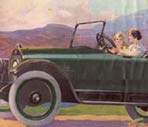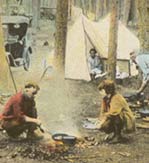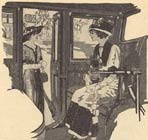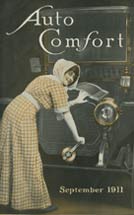
Gender and the Automobile in the United States
Gender and Automobility:
The Pioneering and Early Years
The automobile was from its birth a vehicle that provided personal mobility. It offered movement on an individual level much more effectively than did its predecessor the bicycle or its contemporary the motorcycle, and it gave more choice than did public forms of motorized or steam-powered surface transport like the railroad, the bus, and the electric streetcar. Its appeal, after its early and somewhat mistrustful reception as a plaything for the rich, a sporting toy for the adventurous, and (in rural America) a “devil wagon” that frightened livestock and rutted roads, was very wide. As one farmwoman in the 1920s told an inspector from the United States Department of Agriculture who inquired why her family had bought a car rather than putting indoor plumbing into their home, “You can’t go to town in a bathtub.” Doubtless this woman, like those interviewed for Robert S. and Helen M. Lynd’s renowned studies of the Midwestern community of Muncie, Indiana, otherwise known as Middletown (1929) and Middletown in Transition (1937), exaggerated the value of the vehicle, but there is no doubt that the automobile did have transforming social and economic characteristics.
The earliest examples of these transforming qualities were demonstrated initially in towns and cities, where roads were more likely to be hard-topped, gasoline and spare parts were widely available, and a core group of interested and wealthy sponsors who considered themselves “go-getters” was present. Women as well as men belonged to these circles. They were numerically in the minority, as Clay McShane has suggested, and men often ridiculed their driving. Despite male attempts to limit or prohibit female drivers, famous women motorists, like writers Emily Post and Edith Wharton, and women’s automobile contributions during the World War I years were only the most notable indicators of the existence of a core of urban and suburban women for whom driving was useful, necessary, or adventurous in the early years of the twentieth century.
More American women learned about the possibilities of the automobile from the publicity offered by newspaper coverage of the pioneering transcontinental car journeys that took place between 1899 and 1908. These early drivers and their passengers of both sexes demonstrated that it was possible for the emerging automotive technology to be useful as well as challenging. They simultaneously deflated the car’s critics. These pioneering crossings, however, were made possible by meticulous planning, aided by the telephone, the telegraph, the railroad, and a dealer network ensuring that supplies of gasoline, spare parts, and even relay drivers were nearby when needed. Those who lived in rather than travelled through the countryside soon learned that the automobile was a seasonal vehicle, to be “laid up” on blocks, at least in the winter, because of road conditions. Photographs of impassable country roads frequent the pages of individual state governments’ transportation reports in the 1920s and 1930s. The automobile, regardless of who was driving, was a good weather vehicle for the practical reasons that it got stuck, even though early models sat high off the road to avoid surface hazards.
Road hazards were indeed a problem or an adventure depending on one’s perspectives. So both would-be motorists and motorists of both sexes pressured their local and state authorities to improve the roads. The federal government had been aware of the desirability of developing roads and had discussed funding for highways prior to World War I, but the war itself made that support more urgent, if only for defense or military reasons. The 1920s witnessed an increase in regular federal funding for roads, and that was in turn vastly expanded by relief and stabilization programs during the New Deal in the 1930s. But more importantly, state and local governments responded to motor lobbies and instituted road user taxes for improvements and set up highway agencies to manage their roads. The end result of these efforts was visible in the improvement to and extension of surfaced and good quality surfaced roads. By 1930 some 23% of the national total mileage was surfaced and some 3%, which was concentrated in the systems managed by state agencies, was surfaced to high quality. By 1938 there had been a notable improvement in this situation, with about 37% of the total mileage surfaced and 5% well surfaced. The basic infrastructure supporting automobility in the years before World War II was making progress, but it was less robust than registration of motorcars suggest.
So how did American motorists respond to the limitations and the possibilities of automobility in the early twentieth century? There is no doubt that more Americans wanted to own and actually bought automobiles in the years after World War I because they could see the potential for geographical mobility. Registration of automobiles increased from 6.7 million in 1919 to 23.1 million a decade later. Despite the severe economic registrations rose to 26.2 million in 1939 after dipping downwards to 21.5 million in 1934 before rising to 26.2 million in 1939. Those who owned these vehicles were likely to be white and middle-class. Only small percentages of minority families owned cars. With the growing numbers of sales of second-hand vehicles in the late 1920s, some blue-collar workers were also able to buy into automobility, but their continuing ownership was tied to their ability to stay employed.
In white families, both rural and urban, women gained and enjoyed some access to the motor vehicle. Men continued to consider that they should be granted priority because they were the wage-owners and the head of the household, but this did not mean that women were solely passengers, dependent on their partner to chauffeur them to their desired destinations. Women, like men, could see the advantages of freer movement. As the motor industry geared itself up to increased sales and then to status sales with styling, colors, and most importantly technological improvements to such basics as engines, steering, suspension, brakes, and more easily changeable tires, women knew that they could handle a car like they could “master” household technology or farm machinery. For many women the desire to be mobile overcame the possibility of running into difficulties or damaging the family’s “pride and joy.” Their partners or fathers might wish to restrain their automobility, but banning wives and daughters and sisters from driving was difficult if the women wanted to drive and made a concerted effort to learn.
So did women want to drive as much as did men? They certainly wanted the mobility offered by motorized transportation, whether as passengers or as drivers. Surveys of car usage in the 1920s suggest that travel was for both pleasure and business and that on the weekend automobile journeys were longer and more frequent than during the week. Detailed work on leisure, recreation, and vacations suggest that auto-owning American families took to the roads, despite their surfaces, for visits to local scenic spots, to relatives or friends, to new forms of amusement like the movies, or to go on shopping trips to larger urban centers. More adventurous motorists became long-distance tourists seeking out famous beauty spots or just touring in general. In doing so and finding the social infrastructure wanting, they became autocampers. Moving from “gypsying” or stopping to cook simple meals over campfires and sleeping in tents by the roadside to more formally organised campgrounds with cabins or even to staying in pioneer “motels,” these families were not male-only groups. Females shared the joys and the tribulations of travelling in family cars, and they contributed directly and indirectly to the increasing awareness of auto manufacturers, the newly emerging auto servicing industry, and society in general that a new level of mobility for all Americans was developing. Automobiles could no longer be assumed to be, if they ever had been, exclusively male property. They were family vehicles and were used as such.
Did women drive these family vehicles or did they buy cars themselves? There was much speculation about women’s capacity for mastering auto technology, even about their feeling comfortable alone or with their children while on the road. Negative stereotypes about women’s early automotive behavior abound, but Virginia Scharff firmly put to rest the notion that women were incapable of and temperamentally unsuited to driving cars in the pioneer years of motoring up to the Depression years of the 1930s. Although many men early considered that women should be restricted to the cleaner and slower electric car, which was capable of only 50 miles without complex recharging and was unable to manage steep hills, women soon demanded equal access to the more sturdy and challenging gasoline-fueled vehicle. And besides, who but the rich could afford the luxury of his-and-her vehicles in years that were notable for attempts to market the automobile beyond the elite?
Rural women, in particular, welcomed the possibility of relieving their isolation by driving into town to shop, to sell their farm produce, or to attend farm clubs. Being more familiar with teams and buggies, they were less daunted by the prospect of driving than their urban counterparts, who were more used to walking or taking public transit. They may not have relished the task of hand-cranking the engine, but they were not stymied by this task. Moreover, not only they, but also the males in the family, welcomed the innovation and diffusion of the self-starter, which became more widespread in the 1920s, as did closed rather than open-topped cars. They did not necessarily find easy or independent access to the automobile, as that was still assumed to be the male’s prerogative. In a survey conducted of rural young people in Missouri in 1937, 35% of farm girls drove cars in comparison to 72% of farm boys, but another 37% of farm girls wanted to learn how to drive. Here the significant point to note is the interest and ability of the girls rather than the dominance of the boys. Girls or women who could drive were able to run farm errands and to gain personal access when men were working on the farm. It seems that by 1940 most young and middle–aged farm women who were interested in mobility could and did drive the family car.
Did women buy automobiles? Only wealthy women were able to afford their own vehicles, but many women participated in the purchase of the vehicle. Historians have paid much attention to the marketing of automobiles by their manufacturers and how in the 1920s these men or at least their sales agents realized that they needed to make their vehicles attractive to the female consumer. The nature of the advertisements changed from the earlier pre-World War I descriptions of mechanical parts and small sketches of cars to large color pictures featuring women as passengers or drivers and minimizing auto technology. Moreover, cars needed to be comfortable as well as functional. When General Motors adopted the notion of annual styling in 1927 and then talked about a two-car family in 1929, they only confirmed that they were convinced of the efficacy of appealing to women. Even the long-distance bus companies tried to convince families that the bus could become their second car.
Mobility was infectious, and once gained, whether as a shopping trip to buy groceries, as a means of going to church more easily, or as an escape from parents’ watchful eyes, it was never forgotten and difficult to deny. The automobility of Americans during the depressed 1930s was a huge testimony to the appeal of the motor vehicle. Robert and Helen Lynd marvelled at how depression-proof was car ownership in Middletown’s county during the tough years of the early 1930s. Americans may have curtailed some of their driving and ridden in progressively older vehicles, but they unashamedly continued to ride, suggesting that the automobile was becoming regarded as an essential to many families. Warren Belasco has further noted that middle-class Americans continued their driving expenditures in the first half of the 1930s and were mobile up the recession of 1938. Hotels and early motels may have suffered economically as tourists turned to cheaper and more convenient autocamps or cabin camps, but Americans were still travelling. Indeed the 1935 Census of Business counted 9,848 “tourist camps,” often in the South and the West, and the number of gasoline service stations nearly doubled from 121,513 in 1929 to 241,358 a decade later.
<<Previous Section - Next Section>>
Placing Gender and Automobiles into Perspective
Gender and Automobility: The Pioneering and Early Years
Gender and Automobility: Consumerism and the Great Economic Boom
Gender and Automobility: Sexual Equality in Modern Times
About the Project | Credits | Contact Us | Student & Teacher Resources | Site Map
©2004 Automobile in American Life and Society




